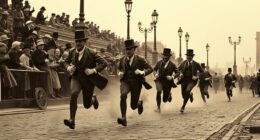In the 1904 Olympic Marathon, a wrong turn led to a chaotic race under scorching heat, where only 14 of the 32 runners finished. You'd witness astonishing mismanagement, with just one water station and bizarre tactics like strychnine use and hitchhiking. Fred Lorz even crossed the line first before being disqualified. The event became a cautionary tale about athlete safety and organization. There's so much more to uncover about this absurd marathon's legacy.
Key Takeaways
- The marathon was marred by extreme heat, with temperatures soaring above 40 degrees Celsius, affecting runners' performance and safety.
- Only one water station near the halfway mark exacerbated dehydration and exhaustion among competitors, leading to chaotic conditions.
- Fred Lorz initially finished first but was disqualified after hitchhiking part of the course, highlighting the race's disorganization.
- Thomas Hicks, the winner, used strychnine and egg whites, showcasing the bizarre lengths athletes resorted to for victory.
- The event's mismanagement and unusual incidents sparked discussions on athlete safety and the need for better marathon organization.

Have you ever heard of a marathon where only 14 out of 32 runners managed to finish? That's exactly what happened at the 1904 Olympic Marathon in St. Louis, and it's a story filled with bizarre twists and turns.
Imagine the scene: scorching temperatures soaring above 40 degrees Celsius and just one water station near the halfway mark. This was a recipe for disaster, leaving many athletes severely dehydrated and exhausted.
One of the more shocking aspects of the race was the performance-enhancing methods employed by competitors. Thomas Hicks, who eventually crossed the finish line as the winner, was assisted by trainers who administered strychnine and egg whites to help him push through the grueling conditions.
Back then, the use of such substances was unregulated, making you wonder how far athletes would go to secure a victory in the intense world of Olympic competition. This bizarre scenario raises questions about athlete safety and the lengths to which individuals were willing to go for glory.
Fred Lorz had initially crossed the finish line first, which should have secured him a gold medal. However, his victory was short-lived, as he was disqualified for hitchhiking part of the course.
Can you imagine the chaos that must have ensued? The disqualification of Lorz revealed the disorganized nature of the event and how little support was provided to the athletes.
With so few runners finishing, the marathon wasn't just an athletic event but a spectacle of mismanagement. The extreme weather conditions took a toll, and discussions about marathon regulations and athlete safety became essential after this chaotic race.
It highlighted the need for better organization and support for runners, ensuring that such a bizarre scenario wouldn't be repeated in future Olympics.
As you think back on that infamous day in 1904, it's hard not to feel a mix of disbelief and sympathy for those runners. They faced not only the challenge of the marathon but also the unpredictable, harsh elements of the day, along with the lack of proper hydration and assistance.
The 1904 Olympic Marathon stands as a cautionary tale, reminding us that even in the pursuit of greatness, athlete safety should always come first.
Conclusion
In the end, the 1904 Olympics marathon stands as a testament to the unpredictable nature of sports. You've seen how a wrong turn can lead to unexpected twists, bizarre events, and unforgettable stories. The runners faced challenges that tested their limits, and their perseverance became legendary. As you reflect on this unusual race, remember that sometimes the most remarkable moments come from the unlikeliest of circumstances, turning an ordinary event into a captivating tale for the ages.









